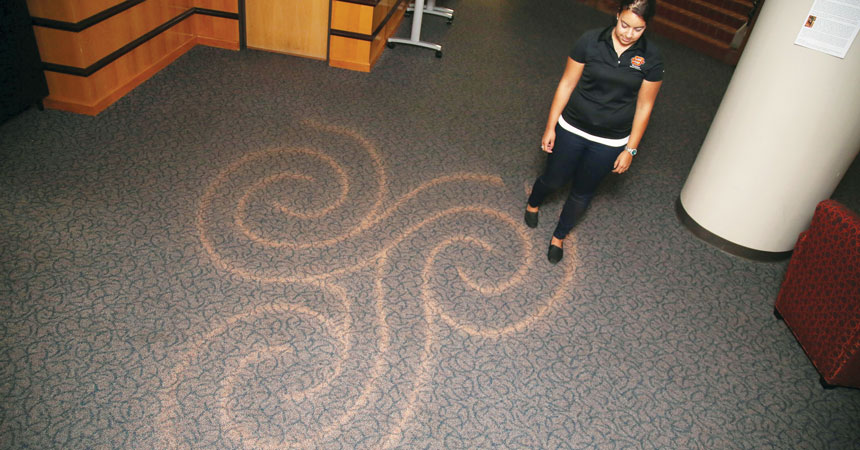A Walk to Wellness
Tuesday, March 21, 2017

Walking the circular path of a labyrinth is a study in relaxation for Megan York, a health education and promotion major. The quiet, dim corner of Oklahoma State University-Tulsa’s Main Hall Commons that houses the Sparq Meditation Labyrinth provides an opportunity for York and others on campus to engage in an increasingly popular wellness exercise.
“Evidence shows that the circular walking patterns of labyrinths help with calmness and mental focus,” says Amy Bowersock, clinical associate professor of health education and promotion. “This calming, meditative effect can have a substantial impact on stress and adds another dimension to our health and wellness efforts.”
Bowersock, whose research interests have focused mainly on physical activity, has begun a study to gather data about the wellness benefits of labyrinths and their meditative effects.
“We are learning more about users’ perceptions of their own personal wellness and how they are benefiting from using the labyrinth,” Bowersock says. “Part of the challenge of this research is understanding how individual perceptions about meditation and wellness influence the actual benefits users experience.”
A labyrinth is a series of winding pathways in a circle around a central point. Users follow the curved path to get to the center. Unlike a maze, a traditional labyrinth has no dead ends.
“Research has shown that the winding pathways enable people to clear their minds from distractions and focus on being in the moment,” says Bowersock. “This practice helps people refocus while they are walking through the labyrinth.”
Wellness innovator Lynn Wallace, access and collection services librarian at OSU-Tulsa, proposed bringing the Sparq labyrinth to OSU-Tulsa.
Helping her mother fight terminal cancer after having just recovered from her own round of cancer treatment had left Wallace emotionally drained.
“I found several meditative ways personally to cope, including coloring, cross-stitching and utilizing a meditation labyrinth,” Wallace says. “After talking to Dr. Bowersock about coping during stressful times, I realized that this was a missing piece of our campus wellness offerings.”
The Sparq Meditation Labyrinth was developed by Matt Cook, emerging technologies librarian at the University of Oklahoma. It has traveled the country to promote the health benefits of mindful meditation at events and academic institutions.
Using a touch-screen interface, the Sparq labyrinth projects a lighted pathway onto the floor. Users are able to select from a variety of culturally significant patterns to suit their mood or meditation goals. The entire process generally takes about five minutes from start to finish.
“Concentration improves, stress hormones are reduced and a sense of calm produces a better end product for the user after a session in the labyrinth,” Wallace says. “Mindfulness meditation while walking the labyrinth enables participants to focus on that moment — being present — not on the paper due in an hour or the test in the next class.”
It also provides a beneficial alternative to consuming high-calorie energy drinks or making unhealthy choices to aid concentration and studying, Wallace says.
According to the University of Edinburgh, labyrinths date back more than 4,000 years, and ancient remains have been found all across the world. Some were purely decorative, while others were constructed for walking.
Bowersock sees many avenues of research branching out from this initial project. She is interested in how adding mindful meditative activities affects a person’s overall physical activity.
“The Setchenov Phenomenon has shown that individuals who are fatigued to exhaustion can reduce fatigue by utilizing a diverting activity while exercising,” Bowersock says. “I’m interested to measure the effect on fatigue that these meditative activities would have on individuals while they are exercising in the wellness center.”
She is also interested in working with youth sports and high school programs to see if the use of the labyrinth could be used for developing mental training and deflating strong emotions in highly stressful situations.
Students in the Health Education and Promotion program also used the labyrinth for several wellness-related class projects during the fall semester.
The temporary labyrinth installation on the OSU-Tulsa campus has elicited a positive response from OSU’s wellness program. The university is looking at add a permanent labyrinth installation on the Stillwater campus, and OSU-Tulsa is looking for ways to adding a permanent labyrinth on campus as well.
“A labyrinth provides an opportunity to students, faculty and staff to take a short walk and regroup mentally,” Bowersock says. “The calming and health benefits users will receive from using the labyrinth are an innovative addition to OSU’s America’s Healthiest Campus® initiatives.”
Story by Sean Kennedy
